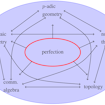Foundation Announces Simons Collaboration on Arithmetic Geometry, Number Theory and Computation
The Simons Foundation is pleased to announce the establishment of the Simons Collaboration on Arithmetic Geometry, Number Theory and Computation, directed by Brendan Hassett of Brown University.
The interplay between experiment, theory and computation has long driven the development of number theory. Tabulations of primes in the 1790s led to Legendre’s formulation of the prime number theorem, which was finally proven in the 1890s. In the 1960s, Birch and Swinnerton-Dyer systematically analyzed solutions of cubic (genus one) curves using an early computer, leading to their celebrated conjecture. The Sato-Tate conjecture and its extensions — which quantify the apparently random behavior of congruences over varying primes — are grounded in extensive computations.
The frontier of research has now moved to curves of higher genus and surfaces. However, here, there is a notable imbalance between extensive theoretical advances and the implementation of computational tools to study these objects. With the computational resources now available, algorithms that leverage these theoretical advances are technically feasible. The collaboration will seek to accelerate research in number theory and arithmetic geometry through the computational realization of deep theory, and to use the computational tools to probe our conceptual understanding of complex arithmetic objects.
More information about the collaboration can be found here.
The Simons Foundation Mathematics and Physical Sciences division will support more collaborations in future years; groups interested in applying should review the Request for Applications available on our website.

Above: Convergence to the Sato-Tate distribution, for increasing prime numbers. (Sato-Tate data: Andrew-Sutherland)


